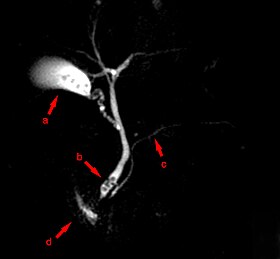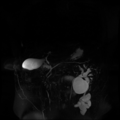Magnetic resonance cholangiopancreatography
| Magnetic resonance cholangiopancreatography | |
|---|---|
 MRCP image showing stones in the distal common bile duct: (a) Gallbladder with stones, (b) Stones in bile duct, (c) Pancreatic duct, (d) Duodenum. | |
| ICD-9-CM | 88.97 |
| MeSH | D049448 |
| OPS-301 code | 3-843 |
Magnetic resonance cholangiopancreatography (MRCP) is a
biliary and pancreatic ducts non-invasively. This procedure can be used to determine whether gallstones are lodged in any of the ducts surrounding the gallbladder
.
Uses
MRCP has been slowly replacing
biliary system, pancreatic duct and accessing surrounding solid organs. Several advantages offered by MRCP is its non-invasive nature, less costly, requires less examination time when compared to ERCP (30 minutes), fewer staff required, and does not require any ionising radiation.[1][2][3][4]
MRCP is used to diagnose
liver cirrhosis and cholangiocarcinoma.[5]
Technique
Subject is needed to fast for at least four hours to ensure the biliary system is maximally distended with fluid while keeping the fluid in the gastrointestinal system at a minimum.Açaí juice and water are useful in decreasing T2 signal intensity, thus minimising signals from stomach and duodenum from interfering with signals from the biliary system.[6]
MRCP makes use of heavily
T2-weighted MRI pulse sequences.[3][7] These sequences show high signal in static or slow moving fluids within the gallbladder, biliary ducts and pancreatic duct, with low signal of surrounding tissue. Secretin is also given to a patient to increase ductal compliance, making imaging easier.[3]
History
It was introduced by Wallner in 1991.[8]
Additional images
-
Benign biliary stricture. 3D File generated from MRCP
-
3D printed model of benign biliary stricture from MRCP data.
-
Normal MRCP (with visible renal cyst)
See also
References
- ^ PMID 21611015.
- S2CID 28902645.
- ^ ISBN 978-0-323-41509-5, retrieved 2021-01-28
- S2CID 25726694.
- ^ ISBN 978-1-4160-2332-6, retrieved 2021-01-28
- ^ Al-Atia, Mohassad. "Can oral contrast enhance image quality at MRCP? - A literature review" (PDF). Örebro University, Sweden. Part of Medicine, advanced level, Degree project. Archived from the original (PDF) on 12 June 2020. Retrieved 7 May 2022.
- PMID 22695995.
- ISBN 978-3-540-35278-5. Retrieved 3 July 2011.



